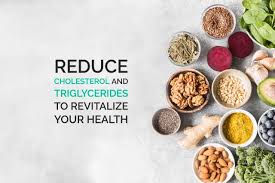
High levels of triglycerides in the blood increase the risk of heart disease, PANCREATITIS , and other health problems
What are triglycerides?
They are a form of fat present in the body, where most of the body fat is stored as triglycerides. Triglyceride levels can be determined by a blood test.
- They provide energy to the body. When the body needs energy, it releases triglycerides from fat cells.
- They help regulate body temperature. Body fat, which includes triglycerides, helps keep the body warm.
- They protect internal organs. Body fat, which includes triglycerides, helps protect internal organs from shock and injury.
Normal triglyceride levels, as cited by Medical News Today, are:
- Children under 10 years: less than 75 mg/dl
- While for those over 10 years old and adults it should be less than 90 mg/dl
Diet plan to reduce triglycerides
To reduce triglycerides, the following 7-day meal plan is proposed, which offers a variety of nutritious and delicious options. It is important to remember that this is just an example and nutritional needs may vary from person to person. Therefore, it is recommended to consult with a health professional for a personalized plan.
This is just an example and each person’s nutritional needs may vary . It is also recommended to consult with a health professional for a personalized plan.
Day 1
Breakfast: Old-fashioned oatmeal with low-fat or plant-based milk, topped with berries and seeds
Lunch: Vegetable and lentil soup with whole-grain crackers
Dinner: Tofu and pumpkin curry with cauliflower rice
Snack: A banana and almonds
Day 2
Breakfast: Salmon, whole grain rye bread and soft-boiled egg
Lunch: Sardines in a whole-grain wrap accompanied by a salad and oil-based dressing
Dinner: Stir-fried chicken and vegetables with brown rice
Snack: A boiled egg and fresh fruit
Day 3
Breakfast : Buckwheat pancakes with low-fat yogurt and berries
Lunch: Spinach, avocado, and tomato salad with black beans and quinoa
Dinner: Vegetable and bean chili with a side of kale
Snack: Celery sticks and almond butter
Day 4
Breakfast: Low-fat whole grain cereal or plant-based milk and fresh fruit
Lunch: Barley wrap with tuna, lettuce, and tomatoes
Dinner: Grilled salmon or mackerel with steamed vegetables and brown rice
Snack: Nuts
Day 5
Breakfast: Have some soft-boiled eggs on whole-wheat toast
Lunch: A tuna or chicken sandwich made with whole-wheat bread, hummus, and a side salad
Dinner : Grilled steak with steamed vegetables and mashed sweet potatoes
Snack: Fruit salad and low-fat Greek yogurt
Day 6
Breakfast: Whole wheat toast with avocado and hard-boiled egg or smoked salmon
Lunch: Chickpeas and quinoa on a green salad
Dinner: Barley, vegetable and chicken soup with whole-grain crackers
Snack: A homemade smoothie made with low-fat Greek yogurt and berries
Day 7
Breakfast: Oatmeal with low-fat or plant-based milk, topped with fresh fruit
Lunch: Sardine salad served on a whole-wheat bread roll, with a side salad
Dinner: Whole-wheat pasta with tomato sauce and drained kidney beans, and a
side salad Snack : Strawberries
Recommendations
- Consult a healthcare professional for a personalized plan.
- Remember to limit saturated fats to less than 7% of daily calories.
- Reduce consumption of added sugars.
- Limit alcohol consumption.
- Choose complex carbohydrates such as whole grains, fruits and vegetables.
- Perform regular physical activity.
You can lower your triglyceride levels by eating a healthy diet, maintaining a healthy weight, getting regular physical activity, managing medical conditions , and talking to your doctor about medications.
This 7-day plan offers you a guide to start improving your health. Finally, do not hesitate to consult a health professional for the best recommendations based on your lifestyle.






